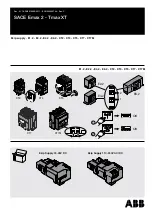
43
Instruction manual
| Types SDV-R and SDV-R-AR distribution circuit breakers
Check of wiring and terminals
1. Physically check all the circuit breaker
wiring for evidence of abrasion, cuts,
burning or mechanical damage.
2. Check all terminals to be certain they
are solidly attached to their respective
device.
Automatic spring-charging check
(control power required)
Repeat the automatic spring-charging check
on page 19 described in the section
describing the installation checks and initial
functional tests.
Primary tasks of this check are:
1. The circuit breaker must be energized
with control power for this check.
2. Energize the control-power source.
3. When control power is connected to the
circuit breaker, the closing spring
should automatically charge. Visually
verify that the closing spring is charged.
Note:
A temporary source of control power
and test leads may be required if the
control-power source has not been
connected to the circuit breaker. When
control power is connected to the circuit
breaker, the closing spring should
automatically charge.
Hazardous voltage and high-speed moving parts.
Will cause death, serious injury, and property damage.
Do not bypass interlocks or otherwise make interlocks inoperative.
Interlocks must be in operation at all times.
Read instruction manual, observe safety instructions, and use qualified
personnel.
Electrical close and trip check
(control power required)
A check of the circuit breaker control circuits
shall be performed. This check is made with
the control circuit of the circuit breaker
energized.
1. Once the circuit breaker springs are
charged, operate the circuit breaker
electrical close command (via
pushbutton, control switch, or
equivalent means). Verify by both the
sound of the circuit breaker closing and
by the main contact status indicator
that the circuit breaker contacts are
closed.
2. As soon as the circuit breaker has
closed, the automatic spring-charging
process is repeated.
3. After a satisfactory close operation is
verified, operate the circuit breaker
electrical close command (via
pushbutton, control switch, or
equivalent means). Verify by both the
sound of the circuit breaker opening
and by the main contact status
indicator that the circuit breaker
contacts are open.
4. After a satisfactory open operation is
verified, hold the circuit breaker manual
trip button and apply and maintain an
electrical close signal. The circuit
breaker should close, immediately trip,
the close spring should charge, and the
circuit breaker should not attempt to
close again.
Completion of these checks demonstrates
satisfactory operation of auxiliary switches,
internal relays and open and close coils.



































